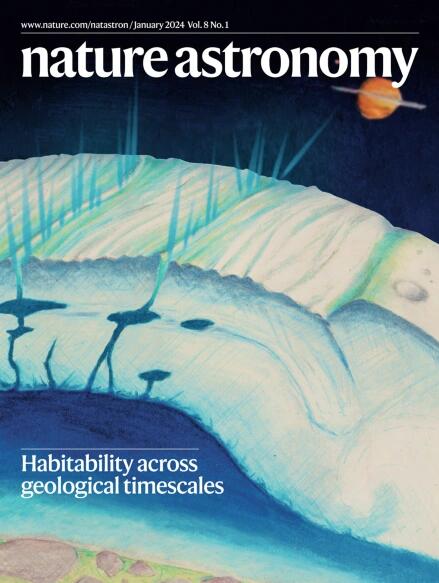SiO and a super-stellar C/O ratio in the atmosphere of the giant exoplanet WASP-121 b
IF 14.3
1区 物理与天体物理
Q1 ASTRONOMY & ASTROPHYSICS
引用次数: 0
Abstract
Refractory elements such as iron, magnesium and silicon can be detected in the atmospheres of ultrahot giant planets. This provides an opportunity to quantify the amount of refractory material accreted during formation, along with volatile gases and ices. However, simultaneous detections of refractories and volatiles have proved challenging, as the most prominent spectral features of associated atoms and molecules span a broad wavelength range. Here, using a single JWST observation of the ultrahot giant planet WASP-121 b, we report detections of H2O (5.5–13.5σ), CO (10.8–12.8σ) and SiO (5.7–6.2σ) in the planet’s dayside atmosphere and CH4 (3.1–5.1σ) in the nightside atmosphere. We measure super-stellar values for the atmospheric C/H, O/H, Si/H and C/O ratios, which point to the joint importance of pebbles and planetesimals in giant planet formation. The CH4-rich nightside composition is also indicative of dynamical processes, such as strong vertical mixing, having a profound influence on the chemistry of ultrahot giant planets. JWST observations suggest that both pebbles and planetesimals played an important role in forming the giant exoplanet WASP-121 b beyond the H2O ice line. They also indicate that strong vertical mixing likely drives the nightside atmospheric chemistry.


在巨大的系外行星WASP-121 b的大气中,SiO和超级恒星的C/O比率
在超高温巨行星的大气中可以探测到铁、镁和硅等难熔元素。这提供了一个机会来量化在形成过程中增加的耐火材料的数量,以及挥发性气体和冰。然而,同时检测耐火材料和挥发物被证明是具有挑战性的,因为相关原子和分子的最突出的光谱特征跨越了很宽的波长范围。通过对超热巨行星WASP-121 b的单次JWST观测,我们报道了在该行星的日侧大气中探测到H2O (5.5-13.5σ)、CO (10.8-12.8σ)和SiO (5.7-6.2σ),在夜侧大气中探测到CH4 (3.1-5.1σ)。我们测量了大气C/H、O/H、Si/H和C/O比值的超级恒星值,这些值表明了卵石和星子在巨行星形成过程中的共同重要性。富ch4的夜侧组成也表明了动力过程,如强烈的垂直混合,对超热巨行星的化学有深远的影响。
本文章由计算机程序翻译,如有差异,请以英文原文为准。
求助全文
约1分钟内获得全文
求助全文
来源期刊

Nature Astronomy
Physics and Astronomy-Astronomy and Astrophysics
CiteScore
19.50
自引率
2.80%
发文量
252
期刊介绍:
Nature Astronomy, the oldest science, has played a significant role in the history of Nature. Throughout the years, pioneering discoveries such as the first quasar, exoplanet, and understanding of spiral nebulae have been reported in the journal. With the introduction of Nature Astronomy, the field now receives expanded coverage, welcoming research in astronomy, astrophysics, and planetary science. The primary objective is to encourage closer collaboration among researchers in these related areas.
Similar to other journals under the Nature brand, Nature Astronomy boasts a devoted team of professional editors, ensuring fairness and rigorous peer-review processes. The journal maintains high standards in copy-editing and production, ensuring timely publication and editorial independence.
In addition to original research, Nature Astronomy publishes a wide range of content, including Comments, Reviews, News and Views, Features, and Correspondence. This diverse collection covers various disciplines within astronomy and includes contributions from a diverse range of voices.
 求助内容:
求助内容: 应助结果提醒方式:
应助结果提醒方式:


